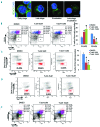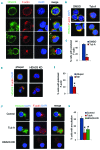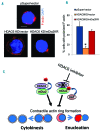Histone deacetylase 6 regulates cytokinesis and erythrocyte enucleation through deacetylation of formin protein mDia2
- PMID: 28255013
- PMCID: PMC5451330
- DOI: 10.3324/haematol.2016.161513
Histone deacetylase 6 regulates cytokinesis and erythrocyte enucleation through deacetylation of formin protein mDia2
Abstract
The formin protein mDia2 plays a critical role in a number of cellular processes through its ability to promote nucleation and elongation of actin filaments. In erythroblasts, this includes control of cytokinesis and enucleation by regulating contractile actin ring formation. Here we report a novel mechanism of how mDia2 is regulated: through acetylation and deacetylation at lysine 970 in the formin homology 2 domain. Ectopic expression of an acetyl-mimic mDia2 mutant in mouse erythroblasts is sufficient to abolish contractile actin ring formation at the cleavage furrow and subsequent erythrocyte cytokinesis and enucleation. We also identified that class II histone deacetylase 6 deacetylates and subsequently activates mDia2. Knockdown or inhibition of histone deacetylase 6 impairs contractile actin ring formation, and expression of a non-acetyl-mimic mDia2 mutant restores the contractile actin ring and rescues the impairment of enucleation. In addition to revealing a new step in mDia2 regulation, this study may unveil a novel regulatory mechanism of formin-mediated actin assembly, since the K970 acetylation site is conserved among Dia proteins.
Copyright© Ferrata Storti Foundation.
Figures







Similar articles
-
Loss of a Rho-regulated actin nucleator, mDia2, impairs cytokinesis during mouse fetal erythropoiesis.Cell Rep. 2013 Nov 27;5(4):926-32. doi: 10.1016/j.celrep.2013.10.021. Epub 2013 Nov 14. Cell Rep. 2013. PMID: 24239357
-
Enucleation of cultured mouse fetal erythroblasts requires Rac GTPases and mDia2.Nat Cell Biol. 2008 Mar;10(3):314-21. doi: 10.1038/ncb1693. Epub 2008 Feb 10. Nat Cell Biol. 2008. PMID: 18264091
-
mDia2 induces the actin scaffold for the contractile ring and stabilizes its position during cytokinesis in NIH 3T3 cells.Mol Biol Cell. 2008 May;19(5):2328-38. doi: 10.1091/mbc.e07-10-1086. Epub 2008 Feb 20. Mol Biol Cell. 2008. PMID: 18287523 Free PMC article.
-
Rho GTPases in erythroid maturation.Curr Opin Hematol. 2014 May;21(3):165-71. doi: 10.1097/MOH.0000000000000032. Curr Opin Hematol. 2014. PMID: 24492678 Free PMC article. Review.
-
Lysine acetylation of cytoskeletal proteins: Emergence of an actin code.J Cell Biol. 2020 Dec 7;219(12):e202006151. doi: 10.1083/jcb.202006151. J Cell Biol. 2020. PMID: 33044556 Free PMC article. Review.
Cited by
-
Regulation of INF2-mediated actin polymerization through site-specific lysine acetylation of actin itself.Proc Natl Acad Sci U S A. 2020 Jan 7;117(1):439-447. doi: 10.1073/pnas.1914072117. Epub 2019 Dec 23. Proc Natl Acad Sci U S A. 2020. PMID: 31871199 Free PMC article.
-
Lysine Deacetylase Substrate Selectivity: Distinct Interaction Surfaces Drive Positive and Negative Selection for Residues Following Acetyllysine.Biochemistry. 2023 May 2;62(9):1464-1483. doi: 10.1021/acs.biochem.3c00001. Epub 2023 Apr 12. Biochemistry. 2023. PMID: 37043688 Free PMC article.
-
Identification of potential chemical compounds enhancing generation of enucleated cells from immortalized human erythroid cell lines.Commun Biol. 2021 Jun 3;4(1):677. doi: 10.1038/s42003-021-02202-1. Commun Biol. 2021. PMID: 34083702 Free PMC article.
-
Epigenetic and Transcriptional Control of Erythropoiesis.Front Genet. 2022 Mar 7;13:805265. doi: 10.3389/fgene.2022.805265. eCollection 2022. Front Genet. 2022. PMID: 35330735 Free PMC article. Review.
-
Analyses of erythropoiesis from embryonic stem cell-CD34+ and cord blood-CD34+ cells reveal mechanisms for defective expansion and enucleation of embryomic stem cell-erythroid cells.J Cell Mol Med. 2022 Apr;26(8):2404-2416. doi: 10.1111/jcmm.17263. Epub 2022 Mar 5. J Cell Mol Med. 2022. PMID: 35249258 Free PMC article.
References
Publication types
MeSH terms
Substances
Grants and funding
LinkOut - more resources
Full Text Sources
Other Literature Sources
Molecular Biology Databases

